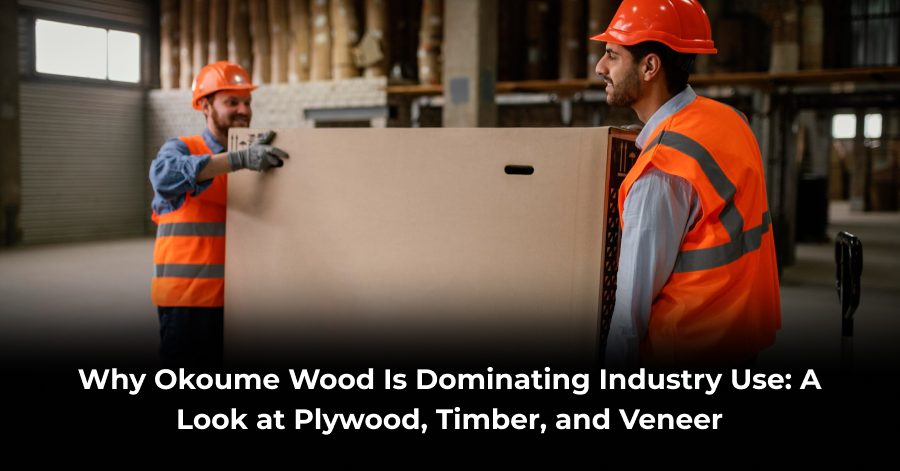The Rise of Okoume Wood Across Industries
Over the past few years, Okoume wood has gained serious traction in the construction, interior design, and manufacturing sectors. What started as a regional export has now become a material of choice in global projects. From marine-grade applications to luxury interiors, the adaptability of Okoume is turning heads. Whether you’re sourcing Okoume plywood for boats or using Okoume timber for furniture frames, this wood is proving itself to be more than just lightweight filler. It’s a practical solution with real commercial value.
Let’s explore why Okoume wood is now leading the charts in key industries and how it compares against more traditional choices like birch.
1. Okoume Wood: A Material With Commercial Appeal
Okoume (Aucoumea klaineana) is native to Central Africa and widely known for its lightweight, smooth-grained, pinkish-brown appearance. It is used in solid timber, plywood, and as a face veneer across a variety of build types. Its growing popularity comes down to a powerful mix of factors:
- Cost-effective
- Easy to handle
- High finish quality
- Adaptable to various treatments and applications
This versatility makes it a go-to option for builders and designers working under strict quality, budget, and timeline demands.
2. Okoume Plywood: Strong, Light, and Ready to Work
Okoume plywood is one of the top-performing materials in applications where weight reduction and ease of fabrication matter. It’s widely used in:
- Marine construction
- Interior paneling
- Lightweight furniture
- Mobile homes and RV interiors
The key benefits include:
- Smooth surface for high-end finishes
- Lightweight sheets for easier transport and installation
- Excellent machinability for CNC or manual fabrication
Marine-grade Okoume plywood, in particular, is bonded with waterproof adhesives and often sealed to prevent rot and fungal growth. It holds up well under harsh conditions, which is why boatbuilders and marine engineers regularly specify it in their builds.
3. Okoume Timber: Lightweight With Structural Integrity
Okoume timber offers a lightweight alternative to denser hardwoods like oak or maple. It may not be as hard, but it provides enough structural support for use in non-load-bearing framing, cabinetry, and decorative structures.
Its key applications include:
- Furniture frames
- Panel substrates
- Partition walls
Because it machines easily and holds fasteners well, it’s a top choice for production teams aiming for volume output without excessive wear on tools or machinery. In terms of scalability, Okoume timber is ideal for mass production lines and pre-fab systems.
4. Okoume Face Veneer: Premium Look Without Premium Costs
Interior designers and manufacturers are increasingly turning to Okoume face veneer for one simple reason: appearance. It offers a premium visual finish with a soft grain, ideal for high-end furniture, wall panels, and cabinet doors.
Advantages include:
- Even grain for consistent aesthetics
- Easy staining and finishing
- Low reject rates due to defects
When bonded to engineered cores like MDF or plywood, Okoume veneer delivers the look of luxury hardwood without inflating the budget. It’s commonly used in:
- Corporate interiors
- Retail display panels
- Residential feature walls
5. Okoume Plywood vs Birch: The Performance Breakdown
Many builders and procurement teams are comparing Okoume plywood vs birch to identify cost-saving opportunities. Here’s how they stack up:
| Feature | Okoume Plywood | Birch Plywood |
| Weight | Light | Heavy |
| Cost | Lower | Moderate to High |
| Grain | Smooth and uniform | Tight, more visible |
| Machinability | High | Moderate |
| Finish Quality | Excellent | Good |
| Tool Wear | Low | Higher over time |
While birch plywood is known for its durability, Okoume plywood often wins out in applications where handling, cost, and finish are more important than extreme load-bearing strength.
6. Cross-Industry Applications of Okoume wood: Why Everyone’s Talking About It
Across industries, Okoume wood is being embraced for its ability to check multiple boxes:
- Marine: Boat interiors, hull linings, lightweight cabinetry
- Furniture: Modern flat-pack furniture, drawer bases, table frames
- Construction: Wall panels, partitions, ceiling features
- Transport: Interior panels in vans, RVs, and aviation cabins
Its availability in multiple formats (solid, plywood, veneer) gives procurement teams flexibility to standardize materials across builds without compromising on performance.
7. Sustainability and Global Sourcing
With global interest rising, many suppliers now offer FSC-certified Okoume wood, ensuring responsible forest management. For brands focused on sustainability, this makes Okoume an even more attractive choice.
Add to that a growing network of reliable international exporters, and it’s easy to integrate Okoume into existing supply chains. Whether you’re importing sheets or sourcing locally, lead times are more predictable than ever.
8. What Builders and Designers Are Saying
From first-time users to experienced fabricators, the feedback on Okoume is consistent:
- “Much easier to work with than birch.”
- “It stains beautifully, no blotches.”
- “We cut down on shipping weight significantly.”
These aren’t just nice-to-haves. They translate directly to faster builds, lower costs, and more satisfied clients.
Okoume wood- A Material That Delivers on All Fronts
Okoume wood isn’t a passing trend—it’s a functional, flexible, and future-proof material. Whether you’re in marine construction, interior fit-outs, or lightweight manufacturing, Okoume offers benefits across every layer of your project.
From Okoume plywood to solid timber and decorative veneers, it checks all the right boxes: quality, workability, appearance, and value. For any team that needs to meet tight deadlines without compromising on material integrity or aesthetics, Okoume is the answer.
Ready to Switch to Okoume?
Get in touch with us for Okoume plywood, timber, or veneer pricing. We’ll help you match the right product to your next build or design project.






